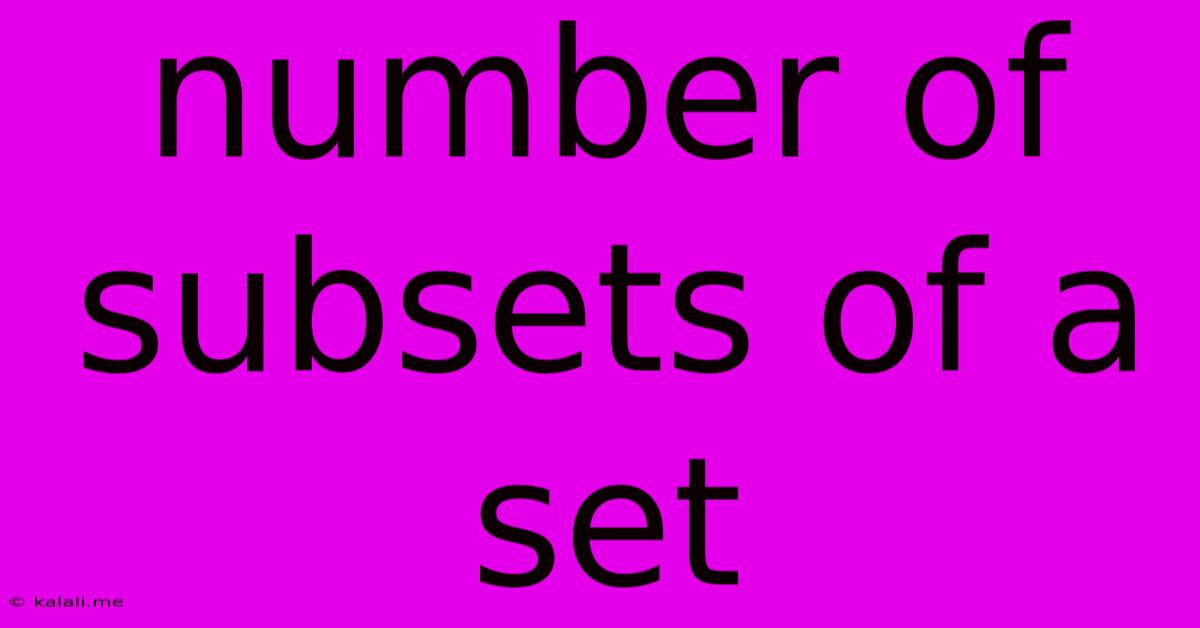Number Of Subsets Of A Set
Kalali
May 30, 2025 · 3 min read

Table of Contents
Understanding the Number of Subsets of a Set: A Comprehensive Guide
This article explores the concept of subsets and provides a clear explanation of how to determine the number of subsets a given set possesses. Understanding this fundamental concept is crucial in various fields like mathematics, computer science, and probability theory. This guide will cover the basics, provide formulas, and offer practical examples to solidify your understanding.
What is a Subset?
A subset is a set whose elements are all members of another set (the larger set). The larger set is often called the superset. Importantly, a set is considered a subset of itself, and the empty set (a set containing no elements, denoted as {}) is a subset of every set.
For example, if we have a set A = {1, 2, 3}, then some of its subsets are:
- {1}
- {2, 3}
- {1, 2}
- {1, 2, 3} (A itself)
- {} (the empty set)
How to Calculate the Number of Subsets
The number of subsets of a set is always a power of 2. Specifically, if a set has 'n' elements, then it has 2<sup>n</sup> subsets. This includes the empty set and the set itself.
This formula arises from the fact that each element in the original set can either be included or excluded when forming a subset. For each element, there are two choices (include or exclude), and since there are 'n' elements, the total number of possibilities is 2 multiplied by itself 'n' times – resulting in 2<sup>n</sup>.
Examples
Let's illustrate this with some examples:
-
Set A = {1}: This set has 1 element (n=1). Therefore, the number of subsets is 2<sup>1</sup> = 2. The subsets are {1} and {}.
-
Set B = {a, b}: This set has 2 elements (n=2). The number of subsets is 2<sup>2</sup> = 4. The subsets are {a}, {b}, {a, b}, and {}.
-
Set C = {x, y, z}: This set has 3 elements (n=3). The number of subsets is 2<sup>3</sup> = 8. The subsets are {x}, {y}, {z}, {x, y}, {x, z}, {y, z}, {x, y, z}, and {}.
-
Set D = {red, green, blue, yellow}: This set has 4 elements (n=4). The number of subsets is 2<sup>4</sup> = 16. (Listing them all would be lengthy but follows the same pattern.)
Practical Applications
The concept of subsets and calculating their number has significant applications in various areas:
- Combinatorics: It helps in counting the number of combinations possible.
- Probability: It is fundamental in calculating probabilities of events.
- Computer Science: It's used in set theory operations and data structures.
- Power Sets: The set of all subsets of a given set is called its power set. The power set of a set with n elements has 2<sup>n</sup> elements.
Conclusion
Understanding how to calculate the number of subsets of a set is a fundamental skill in discrete mathematics and has widespread applications in various fields. By remembering the simple formula 2<sup>n</sup> and practicing with examples, you can confidently tackle problems involving subsets and their counts. This knowledge will provide a strong foundation for more advanced topics in mathematics and computer science.
Latest Posts
Latest Posts
-
My Family And I Or Me
May 31, 2025
-
Only Instrument That Reads Alto Clef
May 31, 2025
-
How Many Different Combinations Of 3 Numbers
May 31, 2025
-
How To Feed A Minecraft Horse
May 31, 2025
-
How To Email Your Boss About A Family Crisis
May 31, 2025
Related Post
Thank you for visiting our website which covers about Number Of Subsets Of A Set . We hope the information provided has been useful to you. Feel free to contact us if you have any questions or need further assistance. See you next time and don't miss to bookmark.